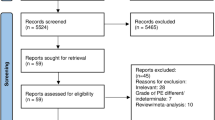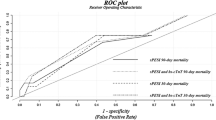Abstract
Pulmonary embolism (PE) is a major cause of cardiovascular death. Thrombolytic therapy was shown to reduce mortality, especially in high risk patients. In elderly patients (>65 years old) with PE, thrombolytic therapy may be underused due to risk of hemorrhagic complications. In this study, we aimed to assess the effectiveness and safety of thrombolytic therapy among elderly patients with PE. 363 patients (205 subjects in study group, 158 subjects in control group) who were admitted to our hospital with PE were enrolled to the study. The patients were divided into subgroups according to their age and treatment strategy. Mortality rates and bleeding complications according to TIMI bleeding criteria in 30 days and 1-year were analyzed. In elderly patients, total mortality (7.8 vs. 20.1 %, p = 0.05) and mortality at 1-year follow-up (1.9 vs. 12.9 %, p = 0.03) was significantly lower in patients who received thrombolytic treatment. Difference in total bleeding (9.8 vs. 4.5 %, p = 0.18) and major bleeding (3.9 vs. 0.6 %, p = 0.10) in thrombolytic and non-thrombolytic groups was non-significant. Thrombolytic therapy is associated with lower mortality and acceptable bleeding complication rates in PE patients older than 65 years old.
Similar content being viewed by others
References
Stein PD, Henry JW (1995) Prevalence of acute pulmonary embolism among patients in a general hospital and at autopsy. Chest 108:978–981
Goldhaber SZ, Visani L, De Rosa M (1999) Acute pulmonary embolism: clinical outcomes in the International Cooperative Pulmonary Embolism Registry (ICOPER). Lancet 353:1386–1389
Heit JA (2006) The epidemiology of venous thromboembolism in the community: implications for prevention and management. J Thromb Thrombolysis 21:23–29
National Center for Health Statistics (2008) Instructions for Classifying the Underlying Cause-of-Death, ICD-10, pp 1–259. http://www.cdc.gov/nchs/about/major/dvs/im.htm. Accessed 10 June 2009
Daniels LB, Parker A, Patel SR et al (1997) Relation of duration of symptoms with response to thrombolytic therapy in pulmonary embolism. Am J Cardiol 80(2):184–188
Becattini C, Agnelli G (2001) Risk factors for adverse short-term outcome in patients with pulmonary embolism. Thromb Res 103:V239–V244
Becattini C, Vedovati MC, Agnelli G (2007) Prognostic value of troponins in acute pulmonary embolism: a meta-analysis. Circulation 116:427–433
Kröger K, Moerchel C, Moysidis T et al (2010) Incidence rate of pulmonary embolism in Germany: data from the federal statistical office. J Thromb Thrombolysis 29(3):349–353
Fengler BT, Brady WJ (2009) Fibrinolytic therapy in pulmonary embolism: an evidence-based treatment algorithm. Am J Emerg Med 27:84–95
Bauersachs RM (2012) Use of anticoagulants in elderly patients. Thromb Res 129:107–115
Spencer FA, Gore JM, Lessard D et al (2008) Venous thromboembolism in the elderly. A community-based perspective. Thromb Haemost 100:780–788
De Breucker S, Herzog G, Pepersack T (2010) Could geriatric characteristics explain the under-prescription of anticoagulation therapy for older patients admitted with atrial fibrillation? A retrospective observational study. Drugs Aging 27:807–813
Moutzouris JP, Chow V, Yong C et al (2014) Acute pulmonary embolism in individuals aged 80 and older. J Am Geriatr Soc 62(10):2004–2006
Konstantinides SV, Torbicki A, Agnelli G et al (2014) ESC guidelines on the diagnosis and management of acute pulmonary embolism. Eur Heart J. doi:10.1093/eurheartj/ehu283
Bovill EG, Terrin ML, Stump DC et al (1991) Hemorrhagic events during therapy with recombinant tissue-type plasminogen activator, heparin, and aspirin for acute myocardial infarction: results of the thrombolysis in myocardial infarction (TIMI), Phase II Trial. Ann Intern Med 115:256–265. doi:10.7326/0003-4819-115-4-256
Berghaus TM, Thilo C, Bluethgen A et al (2010) Effectiveness of thrombolysis in patients with intermediate-risk pulmonary embolism: influence on length of hospital stay. Adv Ther 27(9):648–654
Kasper W, Konstantinides S, Geibel A et al (1997) Management strategies and determinants of outcome in acute major pulmonary embolism: results of a multicenter registry. J Am Coll Cardiol 30:1165–1171
Meyer G, Vicaut E, Danays T et al (2014) Fibrinolysis for patients with intermediate-risk pulmonary embolism. N Engl J Med 370(15):1402–1411
Kanter DS, Mikkola KM, Patel SR et al (1997) Thrombolytic therapy for pulmonary embolism: frequency of intracranial hemorrhage and associated risk factors. Chest 111:1241–1245
Levine MN (1995) Thrombolytic therapy for venous thromboembolism: complications and contraindications. Clin Chest Med 16:321–328
Mikkola KM, Patel SR, Parker JA et al (1997) Increasing age is a major risk factor for hemorrhagic complications after pulmonary embolism thrombolysis. Am Heart J 134:69–72
Lin BW, Schreiber DH, Liu G et al (2012) Therapy and outcomes in massive pulmonary embolism from the Emergency Medicine Pulmonary Embolism in the Real World Registry. Am J Emerg Med 30(9):1774–1781
Ibrahim SA, Stone RA, Obrosky DS et al (2008) Thrombolytic therapy and mortality in patients with acute pulmonary embolism. Arch Intern Med 168(20):2183–2190
Wood KE (2002) Major pulmonary embolism—review of a pathophysiologic approach to the golden hour of hemodynamically significant pulmonary embolism. Chest 121(3):877–905
Conflict of interest
The authors declare that they have no conflict of interest.
Author information
Authors and Affiliations
Corresponding author
Rights and permissions
About this article
Cite this article
İpek, G., Karataş, M.B., Onuk, T. et al. Effectiveness and safety of thrombolytic therapy in elderly patients with pulmonary embolism. J Thromb Thrombolysis 40, 424–429 (2015). https://doi.org/10.1007/s11239-015-1214-6
Published:
Issue Date:
DOI: https://doi.org/10.1007/s11239-015-1214-6




